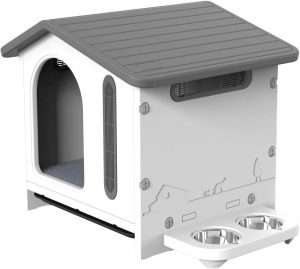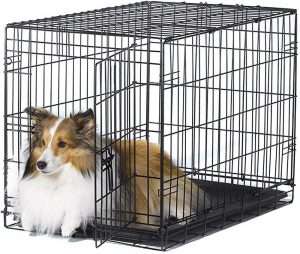
Dog’s Tail Between Legs: Does This Mean They’re Sick?
-
 By
Victoria Bennett
By
Victoria Bennett
- Last updated:

Let’s say you’ve just noticed that your dog has been keeping its tail between its legs more than usual. You’re not sure what it means, and you’re starting to get a little worried. You might be wondering, “Does this mean they’re sick?”
There are a few common challenges people have when their dog keeps its tail between its legs. One of the most common challenges is misunderstanding what this behavior means. People often assume that if their dog keeps its tail between its legs, it means that the dog is sick. However, this isn’t always the case.
Whether you’re a new fur parent or you’ve had your furry friend for years, it’s hard enough for you to see them exhibit unusual behavior, let alone trying to decode what it might mean. So before we go any further, let’s take a look at some of the most common reasons why dogs put their tails between their legs.
Table of Contents
What Does A Dog's Tail Between Their Legs Mean?
Understanding your dog’s behavior is key to being a good pet parent. After all, our dogs can’t tell us what they’re feeling in words, so we have to rely on their actions and body language to clue us in. When it comes to a dog’s tail between its legs, there are a few different scenarios that could be going on. Contrary to popular belief, this doesn’t indicate that the dog is automatically sick. It could be a factor, but this isn’t the only case.
Fear
It’s natural for dogs to be afraid of certain things. Just like us, they can pick up on when something isn’t quite right. If there’s a loud noise outside or someone strange in the house, it’s not uncommon for a dog to tuck its tail between its legs as a way of feeling more protected. Often, when a dog exhibits this behavior, it will also be shaking and might even pee or poop on itself. This is known as submissive urination and can happen when the dog feels overwhelmed, scared, or anxious.
Anxiety
Similar to fear, dogs can also experience anxiety in certain situations. Fear and anxiety, while similar, are not the same thing. Fear is a response to an immediate threat, whereas anxiety is more long-term and can be triggered by things like change, separation, or new environments. If your dog has its tail between its legs and seems restless or agitated, it might be experiencing anxiety. Older dogs or those who have been through a lot of changes in their lives are more prone to anxiety.
There are several things that can trigger a dog’s anxiety. Some of the most common include:
- Loud noises
- Strangers or unfamiliar environments
- Changes in routine
- Separation from their pet parent
- Being left alone
Submission
In some cases, when a dog puts its tail between its legs, it’s simply submitting to another dog or person. This is often seen in dogs who are not used to being around other animals or people. This doesn’t necessarily mean they’re weak – in fact, some dogs who are very submissive can be pretty tough. It’s just your dog’s way of saying, “I’m not looking for a fight.”
Sickness
While it’s not the most common reason, there are some instances where a dog’s tail between its legs can be a sign of sickness. If your dog is also lethargic, has diarrhea, or is vomiting, these could be signs that something is wrong, and you should take them to the vet.
Other Reasons
There are a few other reasons why your dog might have its tail between its legs. If you’ve recently scolded them or they’re feeling guilty about something, this could be their way of apologizing. Dogs are also known to put their tails between their legs when they’re tired or cold. In these cases, they’re usually looking for a little bit of warmth or comfort.

Is It Normal For Dogs To Have Their Tails Between Their Legs?
Now that we’ve gone over some of the most common reasons why dogs put their tails between their legs, you might be wondering if this is normal behavior. The answer is yes – in most cases, it’s perfectly normal for dogs to have their tails between their legs.
What’s not normal is if your dog is constantly tucking its tail between its legs or if the behavior suddenly starts out of the blue. If this is the case, it’s best to take them to the vet to rule out any potential health issues.

What To Do If Your Dog Has Their Tail Between Their Legs
Most of the time, there’s no need to worry if your dog has its tail between its legs. As mentioned earlier, this behavior can be caused by a variety of things, many of which are perfectly normal. It goes away once the dog feels safe or is out of the threatening situation.
However, if you’re concerned about their behavior, there are a few things you can do to help them feel better:
Assess the Situation
The first thing you should do is take a step back and assess the situation. If there’s something that’s causing your dog to feel fear or anxiety, try to remove them from the situation if possible. For example, if they’re afraid of loud noises, bring them inside or put them in a room where they can’t hear the noise.
Once you’ve assessed the situation, look for calming signals from your dog. These are things like licking their lips, yawning, or putting their tail between their legs. If you see these signals, it means they’re feeling overwhelmed and need some help to calm down. Comfort them with a hug or pet them until they start to relax.
Provide Rewards
If your dog is responding positively to your calming signals, reward them with a treat or some verbal praise. This will help reinforce the behavior and make them more likely to do it again in the future.
When doing positive reinforcement, it is crucial that you only give rewards when the dog is behaving in the way you want. If you reward them for putting their tail between their legs, they will start to see this as a desirable behavior and may often do it even when there’s no threat present.
Never Punish
Punishing your dog for putting their tail between their legs will only make them more scared and anxious. This will only worsen the behavior, so it’s best to avoid doing this altogether. Remember, the goal is to help your dog feel safe and comfortable, not scare them or make them feel guilty.
Create a Safe Space
If your dog is struggling with anxiety or fear, you might want to consider creating a safe space for them. This could be a room in your house where they can go when they’re feeling scared or overwhelmed. Make sure the room is comfortable and has plenty of toys and things to chew on. You can also put a blanket or some other type of soft bedding in there for them to relax on.
Take Them to the Vet
If this behavior has been going on for a while and your dog is constantly tucking its tail between its legs, it’s a good idea to take them to the vet. This behavior could be a sign of an underlying health condition, so it’s best to get them checked out just to be safe.
Differentiating Other Circumstances Vs. Illness
There are a few things that you can look for to differentiate between other circumstances and illness.
Look for Physical Signs of Illness
One of the most common signs of illness in dogs is a change in their behavior. Vomiting, diarrhea, and lethargy are all signs that your dog may be sick. If you notice any of these changes, it’s best to take them to the vet right away.
Check Their Stool
Another sign that your dog may be sick is if its stool is loose or contains blood. This can be a sign of gastrointestinal issues, so it’s best to get them checked out by a vet.
Changes in Appetite
If your dog usually has a hearty appetite but is now refusing to eat, this could be a sign of illness. Dogs will often stop eating when they’re feeling sick in order to avoid putting more strain on their system.
Look for Behavioral Changes
Dogs may also exhibit changes in behavior when they’re sick. This can include being inactive and lethargic or hiding away from people and other animals. If your dog is unusually quiet or seems to be in pain, it’s best to take them to the vet.
Look for Changes in Their Coat
If your dog’s coat is dry, brittle, or shedding more than usual, this could be a sign of illness. This shouldn’t be confused with normal shedding, which typically happens twice a year. Dog breeds that shed a lot, such as Labrador Retrievers and German Shepherds, may also have more hair in their coats during shedding season.
When in doubt, always err on the side of caution and take your dog to the vet if you’re concerned about their health. This is the best way to ensure that they’re getting the care they need.

Keeping Your Dog Healthy And Happy
A dog’s tail in between its legs is often a defense mechanism. It’s their way of communicating and letting you know that there’s something wrong with them – either physically or emotionally. However, that doesn’t mean that you should ignore this behavior altogether. Keeping your dog happy and healthy will limit this behavior, and this can be achieved by:
Shower Your Dog with Love and Affection
Dogs are affectionate creatures. They love to be around their humans and feel loved and appreciated. Make sure you give your dog plenty of attention, petting, and verbal praise. This will make them feel happy and secure, which in turn will help reduce anxiety and fear.
Provide a Safe Environment
As mentioned earlier, one way to help reduce a dog’s anxiety is to provide a safe space for them. This could be a room in your house where they feel comfortable and can go when they feel overwhelmed. This will help them feel more secure and less anxious.
Give Them Plenty of Exercise
Dogs are active by nature and need plenty of exercise to stay healthy both physically and mentally. Make sure you’re providing your dog with plenty of opportunities to run and play. This will help them release any pent-up energy and tension, which can lead to less anxiety.
Minimize Stress in Their Life
Dogs are very sensitive to stress, and it can have a negative impact on their health. Make sure you’re doing everything you can to minimize stress in your dog’s life. This includes avoiding loud noises, being consistent with your rules and routines, and not leaving them alone for long periods of time

Final Thoughts
When it comes to our furry friends, we want nothing more than for them to be happy and healthy. But sometimes, their behaviors can be a cause for concern, such as a dog’s tail is in between their legs.
However, it’s important to remember that this behavior is often normal and not a cause for concern. Take into account the things mentioned above. Usually, you’ll see that this behavior is normal and can go away with a few simple changes to your dog’s environment and routine.
If you’re still concerned, never hesitate to take your dog to the vet for a check-up. After all, our dogs are our best friends, and we want nothing but the best for them!
Frequently Asked Questions (FAQ)
Why is my dogs tail down all of a sudden?
A dog’s tail position and movement can provide a lot of information about the dog’s emotional state, health, and well-being. If your dog’s tail is suddenly down, there could be several reasons:
Emotion/Behavioral Reasons:
Submissiveness or Fear: Dogs might lower their tails when they feel threatened, unsure, or submissive.
Stress or Anxiety: A new environment, loud noises, or any situation causing anxiety can lead to a lowered tail.
Depression: Dogs can experience depression, and this may manifest as a lowered tail along with decreased activity and appetite.
Physical Health Reasons:
Tail Injury: Your dog might have hurt its tail. This could have happened while playing, from a fall, or if something heavy dropped on it.
Anal Gland Issues: Dogs have anal glands located on either side of the rectum. If these glands become infected or impacted, it can cause pain and discomfort, leading to a lowered tail.
Arthritis or Spinal Issues: Pain in the hips or lower back can cause a dog to hold its tail down.
General Malaise: If your dog is feeling unwell or has some internal pain, it might lower its tail.
Recent Events:
Grooming: Sometimes after a grooming session, especially if the area around the tail or rear was trimmed or shaved, a dog might feel a bit odd or sensitive and may lower its tail.
Bathing: Similarly, if water got into the anal region or tail base, it might cause temporary discomfort.
Environmental Factors:
Weather: Some dogs lower their tails during inclement weather, especially if it’s cold or wet.
Changes in Environment: A new place, new people, or a change in routine can sometimes be unsettling for a dog.
Behavioral Training:
If you or someone else has been training the dog and using methods that the dog perceives as harsh, it may lower its tail as a sign of appeasement or fear.
If the tail remains down and especially if there are other signs of distress, pain, or behavioral change, you should consult with a veterinarian to rule out any medical issues. If it’s a behavioral concern, you might consider working with a professional dog trainer or behaviorist to address the issue.
Why do female dogs tuck their tails?
Female dogs tuck their tails for many of the same reasons that male dogs do. The tail’s position and movement offer insight into a dog’s emotional and physical state. Here are some reasons why a female dog might tuck her tail:
Emotional/Behavioral Reasons:
Submissiveness: A tucked tail can indicate a submissive posture. It’s a way of saying, “I’m not a threat.”
Fear or Anxiety: Dogs may tuck their tails between their legs when they are scared or anxious.
Uncertainty or Nervousness: An unfamiliar situation or environment might cause a dog to tuck her tail.
Physical Health Reasons:
Pain or Discomfort: Tail injuries, discomfort in the hindquarters, anal gland issues, or general physical malaise can cause a dog to tuck her tail.
Heat Cycle: If a female dog is not spayed, she will go into estrus or “heat.” During certain phases of her cycle, she might tuck her tail to protect her genital area, especially if she’s not yet receptive to mating.
Environmental or Situational Reasons:
Cold or Wet Weather: Some dogs respond to unpleasant weather conditions by tucking their tails.
Recent Interactions: Negative encounters with other dogs, animals, or even humans can lead to a tucked tail.
After Medical Procedures or Grooming:
A recent visit to the vet or grooming can sometimes cause a temporary tail tuck, especially if the experience was stressful or if there was any discomfort involved.
A tucked tail is a communication tool for dogs. It’s essential for dog owners to pay attention to these signals and try to understand the underlying cause. If a dog is consistently tucking her tail and it’s paired with other signs of distress or discomfort, a visit to the vet might be necessary.

Victoria Bennett
About Us
Welcome to doggie site. We stand as the ultimate hub for dedicated dog enthusiasts, combining years of expertise and passion to bring you unparalleled canine insights. Established by a team of canine experts, our platform is rooted in evidence-based practices and a genuine love for dogs, ensuring that you receive the best advice and information.
Latest From Our Blog

























